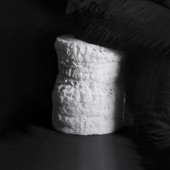Heat:Chair Chair by Xiaobi Iris Pan and Sulaiman Alothman |
Home > Winners > #82025 |
 |
|
||||
| DESIGN DETAILS | |||||
| DESIGN NAME: Heat:Chair PRIMARY FUNCTION: Chair INSPIRATION: Inspired by Tokujin Yoshioda's Pane Chair that uses heat to mediate material properties, the designers of Heat Chair devised an integrated computation and fabrication system to address its limitations, mainly its inability to control material local stiffness. Topology optimization was used to generate the ideal chair form and stiffness distribution for each user, then, robotic folding and heating turns a continuous polyester sheet into the final chair with the desired gradient distribution. UNIQUE PROPERTIES / PROJECT DESCRIPTION: Heat Chair honors the material it uses and the human that uses it. Leveraging the distinct thermo-behavior of amorphous and crystalline zones of polyester fiber, some areas can be melt to bond neighboring layers together without affecting other zones in order to generate the ideal chair with varied stiffness distribution. The final chair as well as its material distribution can be entirely customized for each individual thanks to its computational design and robotic fabrication system. OPERATION / FLOW / INTERACTION: Heat Chair interacts with its user physically and digitally. Physically, the customizable stiffness distribution in the chair allows idiosyncratic sitting behaviors, such as bouncing or designed chair deformation, creating intimate interaction between human and the chair. The chair surface can also be customized to afford unique aesthetics and tactile sensation. Digitally, the chair form as well as the material distribution are determined by human ergonomic data and their preference input. PROJECT DURATION AND LOCATION: The project started in February 2018 in Cambridge, MA, USA and finished in May 2018 in Cambridge, MA, USA. |
PRODUCTION / REALIZATION TECHNOLOGY: Heat Chair is an integrated system that applies first-hand material knowledge about polyester fiber derived from experiments into the generation of a customized chair form and distribution of material in the form. It achieved precise local stiffness control through computer topology optimization and a unique robotic heating, folding and stressing process, resulting in the most efficient and personalized gradient-stiffness chair, able to support 180 kg load from 6 different sitting directions. SPECIFICATIONS / TECHNICAL PROPERTIES: 380mm x 380mm x 500mm TAGS: Computational Design, Robotic Fabrication, Material Based Integrative Design, Thermo Bonding, Gradient Stiffness Distribution, Topology Optimization, Design of Experiment, Polyester, Phase Changing Material RESEARCH ABSTRACT: Heat Chair is a material-based design approach integrating material experiment, design computation with robotic fabrication. Optimal chair material distribution was calculated through topology optimization. To fabricate that, a DOE method was used to analyze effects of various fabrication factors on the material. Finally, the initial topology optimization result became heating parameters that guide the robotic heater for fabrication, creating the most efficient, personalized and economic chair. CHALLENGE: The biggest challenge was to integrate the whole system, from material experiment, to computer topology optimization, to robotic manufacturing, to ensure data flows from one form to another without loss or inaccuracy. Another challenge is to experiment with the material and to analyze data for insights. The designers found that using certain heating method, the treated polyester sample can be modeled as a linear, and thus “computable” material, which laid the basis for the entire system. ADDED DATE: 2019-02-28 23:24:52 TEAM MEMBERS (2) : Xiaobi Pan and Sulaiman Alothman IMAGE CREDITS: Image #1: Photographer Xiaobi Pan, Heat Chair, 2018. Image #2: Photographer Xiaobi Pan, Heat Chair Sitting, 2018. Image #3: Photographer Sulaiman Alothman, The System, 2018. Image #4: Photographer Sulaiman Alothman, The Fabrication, 2018. Image #5: Photographer Sulaiman Alothman, Material Tests, 2018. Video Credits: Photographer Sulaiman Alothman, The Process, 2018. PATENTS/COPYRIGHTS: Copyrights belong to Xiaobi Pan and Sulaiman Alothman, 2019 |
||||
| Visit the following page to learn more: http://www.irispan.net/heatchair | |||||
| AWARD DETAILS | |
 |
Heat:chair Chair by Xiaobi Iris Pan and Sulaiman Alothman is Winner in Generative, Algorithmic, Parametric and AI-Assisted Design Category, 2018 - 2019.· Press Members: Login or Register to request an exclusive interview with Xiaobi Iris Pan and Sulaiman Alothman. · Click here to register inorder to view the profile and other works by Xiaobi Iris Pan and Sulaiman Alothman. |
| SOCIAL |
| + Add to Likes / Favorites | Send to My Email | Comment | Testimonials | View Press-Release | Press Kit |







